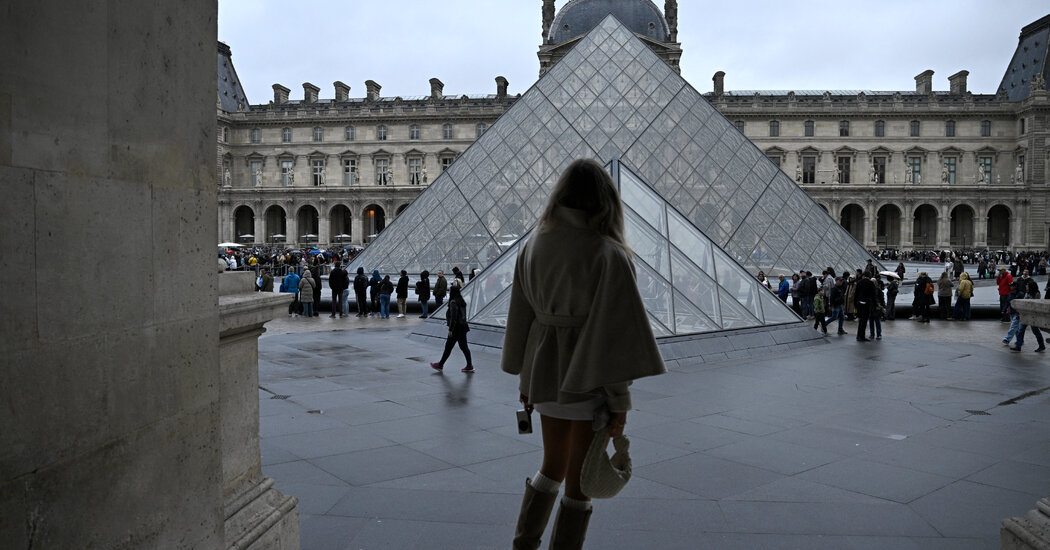Four thieves are believed to have been directly involved in the headline-making heist at the Louvre last month. The police have now nabbed three of the four — two of whom they believe snatched the jewelry, and one of the two whom they think was waiting outside the museum with motor scooters used in the getaway.
The $100 million of iconic jewelry that was taken, however, is still missing.
The burglary happened on Oct. 19 when two of the thieves cut through a window on the second floor of the museum and pulled jewelry out of two glass cases in the Apollo Gallery on that floor, according to the authorities. They say the thieves left the same way they got in, using an electrical ladder mounted on a truck, and then escaped on high-powered motor scooters with the two accomplices waiting for them outside.
The brisk theft — in less than 10 minutes — happened in broad daylight with visitors and museum attendants initially present in the gallery. The brazenness shocked France and the world.
Here’s what to know about the robbery and the ongoing investigation.
How many suspects have been charged and how were they caught?
So far, four people have been charged by the Paris prosecutor overseeing the Louvre robbery investigation. Three of them are suspected of having directly robbed the museum and have been charged with theft by an organized gang. That means one other person whom the police believe to be centrally involved remains at large.
The fourth person who is in custody is a woman, the partner of one of the three suspects being held. She was charged with complicity in the crime. All four were also charged with criminal conspiracy.
DNA samples found at the crime scene were instrumental in the arrests.
Two of those suspects were arrested a little more than a week ago. They are believed to be the ones who broke into the museum.
One of them, an Algerian native, was taken at Paris-Charles de Gaulle Airport as he was about to leave for Algeria on a one-way ticket. The other, a French native, was arrested near his home in Aubervilliers, a Paris suburb. They partially admitted to the crime during their custody hearings, Laure Beccuau, the prosecutor, said at a news conference last week.
On Wednesday night, the police arrested five more people suspected of being involved in the heist. Three were released, but the other two were charged. One is a 37-year-old man who the authorities say is one of the accomplices in the getaway. The other is the woman who the authorities say is his partner.
In an interview with the radio station France Info on Sunday morning, Ms. Beccuau said that the police had found significant DNA traces of the man, but that those of his girlfriend could amount to “transfer DNA” — DNA deposited on someone or something that was at the scene.
Further investigation will determine whether she was actually involved in the crime, Ms. Beccuau said. The woman and her partner both denied involvement, according to the prosecutor’s office.
The three men in custody already had criminal records for thefts and traffic violations, which is why their DNA was in a national database.
What more do we know about the four suspects?
The Paris prosecutor overseeing the case has not named any of the suspects in custody, but has provided some information about their backgrounds. The authorities do not believe they were part of a high-level criminal gang, the prosecutor said.
One of the two suspects believed to have broken into the museum is the Algerian native, 34, who has been living in France for the past 15 years. He has worked as a garbage collector and delivery driver, according to the authorities, and he had already been convicted once for theft, as well as for other minor offenses mainly related to traffic violations.
The other accused of breaking in, the French native, 39, who was arrested near his home in Aubervilliers, worked as a deliverer and driver in the past, the authorities said. There are 15 entries on his criminal record, including two for thefts, the prosecutor said. During his custody hearing in the Louvre case, he acknowledged that one of those thefts involved ramming a car into an A.T.M.
Diala Al-Shaman, a lawyer for one of those suspects, neither of whom has been named, said in a text message that she had no comment.
Réda Ghilaci, one of two lawyers for the other suspect, said he hoped the case would be “handled with the utmost serenity despite the media exposure.”
The male member of the couple now in custody has 11 entries on his criminal record, the prosecutor said, out of which 10 relate to thefts.
The male half of the couple and the 39-year-old suspect appear to know each other: They were both found guilty in a theft case in 2015, Ms. Beccuau said.
What were the security failures at the Louvre?
The museum’s crucial flaw was a dearth of perimeter cameras, the head of the museum, Laurence des Cars, admitted during a hearing at the French Senate several days after the heist.
She added that outdoor cameras were very old and scarce. A New York Times reporter recently counted about 25 cameras on the museum’s perimeter, and only five on the outer walls. There was a camera on the facade of the Apollo Gallery, but it was pointed in the opposite direction of the window where the thieves entered, Ms. des Cars said.
The British Museum, though its perimeter is much smaller than that of the Louvre, has several dozen outdoor cameras.
In another senate hearing on Wednesday, Vincent Annereau, head of the Paris police crime prevention service, said that one of the force’s seven street cameras around the museum captured the thieves’ arrival but that no one noticed anything until they received alerts.
Laurent Nuñez, the French interior minister, told Le Parisien, a French newspaper, on Saturday, “It is impossible to station a police officer behind each of the more than 4,000 cameras currently in operation in Paris.”
What did the burglars steal?
The burglars took eight precious pieces of jewelry, including a sapphire tiara, necklace and matching earring; an emerald necklace and its matching earrings; and a tiara and a brooch worn by Empress Eugénie, wife of Napoleon III.
But they dropped a ninth item, which the authorities recovered later: Empress Eugénie’s crown, which features more than 2,000 diamonds and 56 emeralds.
The thieves deformed the crown, flattening it as they pulled it from the case, Olivier Gabet, head of the Louvre’s art pieces department, told the French daily Le Monde.
But though a few small diamonds and one of its eight gold eagles were missing, Mr. Gabet said he was confident that the crown could be restored. “It will never be in its original condition, but it will be very close and will, of course, retain its full symbolic value,” he said.
Aurelien Breeden and Catherine Porter contributed reporting.
Ségolène Le Stradic is a reporter and researcher covering France.
The post What to Know About the Louvre Heist Investigation appeared first on New York Times.




